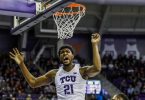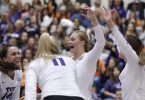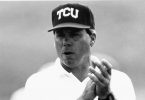Days after the last game of 1998, TCU safeties and roommates Cody Slinkard and Landry Burdine loaded the truck and went deer hunting, ready to get going on their plan of “playing hooky for a couple of weeks.”
Offensive lineman David Bobo, too, had made his way to his deer lease to go off the grid.
They weren’t the only ones.
Most of the players had scattered following a 41-18 thumping of UNLV in Las Vegas on Nov. 21 that had brought the Horned Frogs’ record to 6-5 — pretty decent after a 1-10 season the year before, but not bowl-eligible, not at the time. In those days, you needed seven wins.
When they returned, messages were waiting — get back to campus for a team meeting on Sunday, Dec. 6. Uh-oh, the season had been over for two weeks. Hadn’t they been dismissed? Seniors, too? Did the coach get fired or something?
“Cody and I hadn’t showered in two weeks,” Burdine said. “We were the last ones to walk in. And that’s when we learned we were playing USC.”
And that’s when the Horned Frogs started preparing for the 1998 Sun Bowl, the game in which they upset USC and signaled the start of TCU’s rise to current prominence in college football. The squad will be recognized at halftime of Friday’s game against West Virginia at Amon G. Carter Stadium.
“I love that, man,” Slinkard said of the ‘98 squad’s legacy. “That’s a lot of work going to school and going through all that losing. All the work paying off not just that season but for a couple of decades afterward, that’s something we all take a lot of pride in.”
The 28-19 victory over the Trojans — and it wasn’t that close; the Frogs led 21-0 after Patrick Batteaux’s touchdown run in the second quarter — marked TCU’s first bowl victory in 41 years, since the 1957 Cotton Bowl against Jim Brown and Syracuse.
Today, TCU is in a stretch of 19 bowl appearances in 21 years. The Frogs can make it 20 in 22 seasons if they defeat West Virginia on Friday to gain bowl eligibility.
It all began Dec. 31, 1998, in El Paso.
“Yeah, we definitely think of it that way,” Batteaux said. “That’s the game everybody still talks about today. I have conversations with people. It comes up at least once or twice a month. People see that game as being the turning point of the program in this era.”
The upset was a surprise. So was TCU’s invitation to West Texas. The game had an at-large opening because the Big Ten didn’t have a fifth bowl-eligible team. Options abounded for an opponent for USC, including three WAC teams with a better record than TCU. But those WAC teams — Colorado State, Wyoming and Utah — were all leaving the conference. It made a difference to the Sun Bowl that TCU and UTEP were remaining in the league.
For sure, Dennis Franchione knows TCU made a good case to be invited when he, Chancellor Michael Ferrari, Provost William Koehler, trustee Malcolm Louden, athletic director Eric Hyman and Fort Worth Chamber of Commerce leader Bill Thornton spent a day in El Paso campaigning that the Frogs would bring a crowd (and a good team).
“I’ll never forget when they called me that Sunday morning and said, ‘Coach, you’re in the Sun Bowl,’ “ Franchione said. “I said, ‘That’s great, who do we play?’ They said USC, and I went, ‘Oh.’ Because they had about four or five first-round draft picks at the time — Carson Palmer, Chris Claiborne, a bunch of guys.
“But our players, from Day 1, our goal had been to not just go to a bowl game, but to go to a bowl game and win. Once we gave them the announcement and they settled down from the excitement, it was easy. We had great practices. And when we got to El Paso, we had great workouts, and the guys did a great job of taking a serious approach but also having fun with all the bowl activities.”
The game went pretty much according to plan. Against the eight-win Trojans, Basil Mitchell scored on 3- and 60-yard runs in the first quarter. Batteaux had a second TD run after halftime for a 28-3 lead. Claiborne, USC’s All-America linebacker who went on to an eight-year NFL career, was a non-factor.
“We were really confident in our plan,” Batteaux said. “The Pac 12 didn’t see a whole lot of option. We attacked them. We were just dominating. We actually called off the dogs a little bit.”
Palmer was sacked six times by a rush led by Aaron Schobel and Loren Dunlap. USC had minus-23 yards rushing against a front seven anchored by Shawn Worthen.
“Our team was not without talent,” Burdine said.
“We definitely took TCU for granted,” Palmer, then a freshman, said afterward. “We thought we could do pretty much what we wanted, but they shut us down.”
Bobo was glad to hear it. As one of the players to endure the 1-10 season the year before, he had seen the Frogs tap into their competitive spirit under Franchione and his new staff, which included defensive coordinator Gary Patterson.
“We wanted to win,” said Bobo, an all-state player at high school power Odessa Permian. “It was, ‘Tell me what I need to do — if running into a wall 10 times is going to make us successful, I will do that and we will do that. We wanted that.”
The Frogs weren’t about to waste their bonus game. “They were the more talented team; probably had the better chance to win,” Bobo said. “But we weren’t going to be denied.”
Neither can the effect of the game be denied.
“I still feel the love every time I go on campus,” said Joe Phipps, a linebacker who led the team with four interceptions in 1998. “A lot of people still know me, now my name. That was a special team, really the catalyst that got us jump-started and on the track we’ve been on for the last 20 years.”
“It may be my most favorite game in my coaching career,” said Franchione, who retired in 2015 after 20 years as a head coach at five schools, including Alabama and Texas A&M. “Certainly one of the top two or three.”
It put TCU on the map, heralding a resurgence that eventually led Conference USA to come calling, then the Mountain West, coinciding with a push for a new stadium and eventually Power Five membership in the Big 12 just 13 years later.
“I would have to tell people when I was a free agent: ‘TCU in Fort Worth,’ “ Bobo said, recalling his NFL days. “It wasn’t a household name. You didn’t see those random kids with the purple shirt on like you do today. We may have gotten us on the map, but they have built the program. I think that’s what’s so neat about the experience, the brand that that win has built.”







